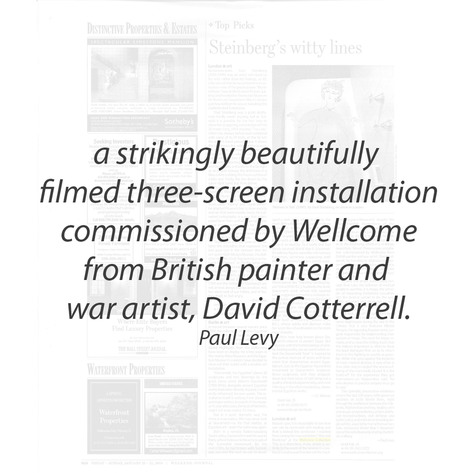Wall Street Journal : London art
Publication Title: Wall Street Journal Weekend JournalPages: W14
Writer: Paul Levy
Publication Date: 23rd January 2009
Reason says it is impossible to see how war can be reconciled with healing, and that is indeed the conclusion I reached from seeing the new exhibition War and Medicine at the Wellcome Collection. This is a disturbing show which is entirely to the credit of the several co-curators in London and Dresden (at the Deutsches Hygiene-Museum); despite the many horrible illustrations of the maimed and close-ups of wounds, the spectator never gets jaded or overcome by gore. The displays remain as horrible and moving at the end of this large show as at the beginning, which is a strikingly beautifully filmed three-screen installation commissioned by Wellcome from British painter and war artist, David Cotterrell. He travelled to Afghanistan, supported also by the Ministry of Defence, and filmed frontline soldiers, in particular the daily activities of the armed forces' medical staff.
If there is a single, overarching concept that rules the behavior of medical people in wartime, it is triage, the principle of separating battlefield casualties into the dead or certain to die, the seriously wounded, and those not so seriously wounded and prioritizing their need for treatment.
The first area of the exhibition deals with the inherent tension of this for Florence Nightingale during the war in the Crimea. But it also features Nikolai Pirogov, the opposing Russian army surgeon responsible for implementing their system of triage. The need for triage remains and so does the chilling truth: that the military imperative is often to treat the least damaged first, so as to return them to the fighting as quickly as possible. While this goes against the instincts of most medical doctors, it very often is their plain duty to neglect the worse suffering of the more badly injured. It is the trade-off for the experience they get themselves-as Hippocrates said, "he who desires to practice surgery must go to war."
This splendid, provocative exhibition covers the last 150 years, with generous sections on both World Wars, right through the conflicts in Vietnam, the Falklands, Afghanistan and Iraq, dealing with poison gas and prosthetics; artists and facial reconstructions, civil- defense and public policy; and, in its most troubling single exhibit, a last letter home from a mentally distressed World War I "deserter," one of those barbarously shot by the British military.
Paul Levy
Download this file here, or click the image on the right.Share:
Twitter / Facebook / Pinterest
